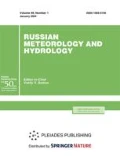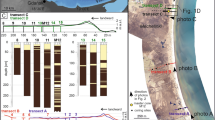Abstract
The history of coastal catastrophic floods was reconstructed for the first time using the geochemical proxy in shelf sediments. The reconstruction is based on the identification of sediment layers accumulated on the shelf during the intensive discharge of the river runoff suspended matter from the land which does not contain bromine. The set of isotopic (AMS 14C, 210Pb, 137Cs), tephrastratigraphic, and paleomagnetic methods was used for the detailed chronology of sediments. The scanning of chemical composition of sediments with the step of 0.5–0.8 mm is performed using the synchrotron radiation X-ray fluorescence in the VEPP-3 storage of the Institute of Nuclear Physics of Siberian Branch of Russian Academy of Sciences. The history of catastrophic floods for the past 1800 years is reconstructed based on the typical variations in bromine concentration in one of the cores from the Amur Bay (the Sea of Japan). New methodological approaches to the flood signal extraction are proposed. The revealed inverse correlation between the frequency of floods caused by typhoons over the coast of the Sea of Japan and southern China agrees with the existing assumption on the change in their trajectories in different periods of global climate change.
Similar content being viewed by others
References
K. I. Aksentov and A. S. Astakhov, “Anthropogenic Pollution of the Peter the Great Gulf Bottom Sediments with Mercury,” Vestnik DVO RAN, No. 4 (2009) [in Russian].
V. A. Akulichev, A. S. Astakhov, M. I. Malakhov, K. I. Aksentov, A. A. Karabtsov, A. A. Mar’yash, and A. V. Alatortsev, “The First Discovery of Cryptotephra of the Catastrophic Eruptions of the Baitoushan Volcano in the Tenth Century A.D. in the Shelf Deposits of the Sea of Japan,” Dokl. Akad. Nauk, No. 6, 649 (2016) [Dokl. Earth Sci., No. 2, 649 (2016)].
A. S. Astakhov, I. A. Kalugin, K. I. Aksentov, and A. V. Dar’in, “Geochemical Indicators of Paleo–typhoons in Shelf Sediments,” Geokhimiya, No. 4 (2015) [Geochemisiry Int., No. 4, 53 (2015)].
A. V. Dar’in, I. A. Kalugin, and Ya. V. Rakshun, “Scanning X–ray Microanalysis of Bottom Sediments Using Synchrotron Radiation from the BINP VEPP–3 Storage Ring,” Izv. Akad. Nauk, Fizika, No. 2, 77 (2013) [Bull. Russ. Acad. Sci.: Physics, No. 2, 77 (2013)].
A. V. Dar’in and Ya. V. Rakshun, “A Method for Measurements to Determine the Elemental Composition of Rock Samples by Synchrotron Radiation X–ray Fluorescence Using VEPP–3 Storage,” Nauchnyi Vestnik Novosibirskogo Gosudarstvennogo Tekhnicheskogo Universiteta, No. 2 (2013) [in Russian].
V. M. Kuptsov, Absolute Geochronology of Bottom Sediments in Seas and Oceam (Nauka, Moscow, 1986) [in Rus sian].
Yu. A. Sapozhnikov, R. A. Aliev, and S. N. Kalmykov, Radioactivity of the Environment: Theory and Practice (BION. Laboratoriya Znanii, Moscow, 2006) [in Russian].
P. P. Tishchenko, P. Ya. Tishchenko, V. I. Zvalinskii, and A. F. Sergeev, “The Carbonate System of Amur Bay (Sea of Japan) under Conditions of Hypoxia,” Okeanologiya, No. 2, 51 (2011) [Oceanology, No. 2, 51 (2011)].
P. G. Appleby and F. Oldfield, “The Calculation of Lead–210 Dates Assuming a Constant Rate of Supply of Unsupported 210–lead to the Sediment,” Catena, 5 (1978).
E. A. Fogarty, J. B. Elsner, T. H. Jagger, K.–B. Liu, and K.–S. Louie, “Variaiions in Typhoon Landfalls over China,” Adv. Atmos. Sci., No. 5, 23 (2006).
I. Kalugin, A. Astakhov, A. Darin, and K. Aksentov, “Anomalies of Bromine in the Estuarine Sediments as a Signal of Floods Associated with Typhoons,” Chin. J. Oceanol. Limnol., No. 6, 33 (2015).
V. N. Karnaukh, A. S. Astakhov, O. F. Vereshchagina, I. B. Tsoy, D. A. Kosmach, S. G. Sagalaev, T. I. Volkova. V. I. Dubina, and I. A. Prushkovskaya, “Formation of Subsurface Shallow Gas Accumulations in Amurskiy Bay (Peter the Great Bay, Sea of Japan) as a Result of Postglacial Sea–level Change, Paleoceanographic Conditions and Hydrological Activity,” Mar. Geol., 372 (2016).
K. Kota, D.–Y. Yang, K. Seto, M. Yasuhara, H. Takata, M. Otsuka, T. Nakanishi, Y. Yoon, I.–K. Um, C. W. Cheung Ri, B.–K. Khim, and K. Kashima, “Factors Controlling Typhoons and Storm Rain on the Korean Peninsula during the Little Ice Age,” J. Paleolimnol., 55 (2016).
Y. V. Kuzmin, G. S. Burr, and A. J. T. Jull, “Radiocarbon Reservoir Correction Ages in the Peter the Great Gulf, Sea of Japan, and Eastern Coast of the Kunashir, Southern Kuriles (Northwestern Pacific),” Radiocarbon, No. 2, 43 (2001).
K.–B. Liu, H. Lu, and C. Shen, “Some Fundamental Misconceptions about Paleotempestology,” Quat. Res., 71 (2009).
K.–B. Liu, C. Shen, and K.–S. Louie, “A 1000–year History of Typhoon Landfalls in Guangdong, Southern China. Reconstructed from Chinese Historical Documentary Records,” Ann. Assoc. Amer. Geogr., No. 3, 91 (2001).
J. L. McKay and T. F. Pedersen, “The Accumulation of Silver in Marine Sediments: A Link to Biologic Ba and Marine Productivity,” Glob. Biogeochem. Cycles, 22 (2008).
P. J. Reimer, E. Bard, A. Bayliss, J. W. Beck, P. G. Blackwell, C. B. Ramsey, C. E. Buck, H. Cheng, R. L. Ed wards, M. Friedrich, P. M. Grootes, T. P. Guilderson, H. Haflidason, I. Hajdas, C. Hatte, T. J. Heaton, D. L. Hoffmann, A. G. Hogg, K. A. Hughen, K. F. Kai ser, B. Kromer, S. W. Manning, M. Niu, R. W. Reimer, D. A. Rich ards, E. M. Scott, J. R. Southon, R. A. Staff, C. S. M. Turney, J. van der Plicht, “IntCal13 and Ma rine 13 Ra dio car bon Age Cal i bra tion Curves 0–50,000 Years Cal BP,” Ra dio car bon, No. 4, 55 (2013).
C. Richter, A. Venuti, K. L. Verosub, and K.–Y. Wei, “Variations of the Geomagnetic Field during the Holocene: Relative Paleointensity and Inclination Record from the West Pacific (ODP Hole 1202B),” Phys. Earth and Planetary Interiors, 156 (2006).
M. Stuiver and T. F. Braziunas, “Sun, Ocean, Climate and Atmospheric 14CO2: An Evaluation of Casual and Spectral Relationships,” Holocene, No. 4, 3 (1993).
M. Stuiver and P. J. Reimer, “Extended 14C Database and Revised CALIB 3.0 14C Age Calibration Program,” Radiocarbon, No. 1, 35 (1993).
I. Tsoy, I. Prushkovskaya, K. Aksentov, and A. Astakhov, “Environmental Changes in the Amur Bay (Japan/East Sea) in the Past 150 Years on the Basis of Diatoms and Silicoflagellates,” Ocean Sci. J., No. 2, 50 (2015).
J. D. Woodruff, J. P. Donnelly, and A. Okusu, “Exploring Typhoon Variability over the Mid–to–late Holocene: Evidence of Extreme Coastal Flooding from Kamikoshiki, Japan,” Quat. Sci. Rev., 28 (2009).
Author information
Authors and Affiliations
Corresponding author
Additional information
Russian Text © A.S.Astakhov, A.V. Dar’in, I.A. Kalugin, K.I. Aksentov, 2019, published in Meteorologiya i Gidrologiya, 2019, No. 1, pp. 91–102.
About this article
Cite this article
Astakhov, A.S., Dar’in, A.V., Kalugin, I.A. et al. Reconstructing the Frequency of Catastrophic Floods on the Western Coast of the Sea of Japan Based on Sedimentary Proxy. Russ. Meteorol. Hydrol. 44, 62–70 (2019). https://doi.org/10.3103/S1068373919010072
Received:
Revised:
Accepted:
Published:
Issue Date:
DOI: https://doi.org/10.3103/S1068373919010072




